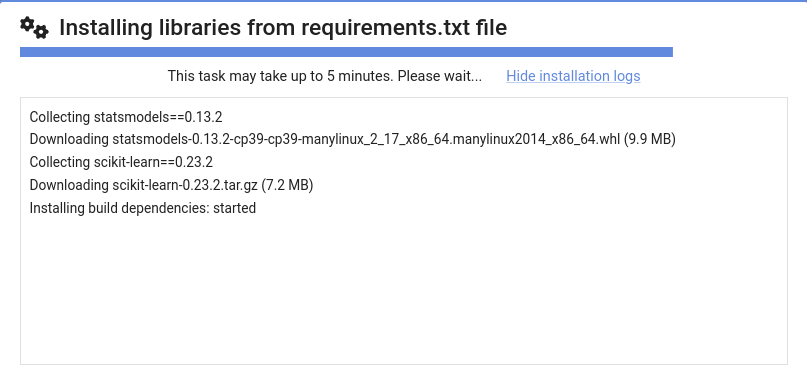Virtual environments in Pyplan act as dedicated spaces for installing Python libraries essential to an application's functionality. Pyplan takes on the responsibility of seamlessly managing these virtual environments, ensuring automatic reloading whenever an application is opened.
Starting from Pyplan version 3.3.1 and onwards, each application benefits from its own distinct virtual environment. This design choice empowers each application to maintain its exclusive set of libraries, optimizing dependency management and ensuring a tailored environment for precise functionality.
¶ Operation
Virtual environment repositories are stored in the .venvs folder, either in the public space or in the user’s workspace.
Different scenarios:
1. An application is opened from the public workspace and the environment for this application does not exist yet: in this case the environment will be created when the application is opened. As this task may take a few minutes, you can view/hide the progress of the environment creation by clicking on the Show installation log/Hide installation log option.

2. An application is opened from the public workspace and the environment for this application already exists: the corresponding virtual environment is mounted, the library repository is compared with the libraries specified in the requirements.txt file, new libraries are installed if necessary.
3. An application is opened from the user’s workspace: if the environment corresponding to the application exists in the user’s workspace, this environment is mounted. If it does not exist, an attempt is made to mount the corresponding environment of the application from the public workspace. If it does not exist either, the environment is created in the user’s workspace.
In case 3 above (if the application is opened from the user’s workspace and the environment is mounted from the public workspace), if the user needs to make changes to the libraries, the following message will be displayed:

This indicates that in order to make changes (either by installing a library using the “pip install” tool or by modifying the requirements.txt file) the virtual environment must be created in the user’s workspace. This task is automatic and is started by clicking on the button: Yes, perform these tasks. This will take some time and then the user will be able to install the necessary libraries.
Perform this action only in case you need to add/modify libraries.
The set of libraries that an application needs is defined in the requirements file (requirements.txt). This file is automatically generated if the user removes a library from the “Installed libraries” tab or adds a new library using the “Install” tab.
¶ Application identifier
Each Pyplan application has a unique identifier that can be viewed by accessing the application properties option.
¶ 1. Identifier
This identifier is generated when a new application is created and is used to identify the virtual environment associated with the application. It is therefore important to ensure that all versions of the same application have the same identifier, as well as that all different applications have their own identifier.
This identifier is generated when a new application is created and is used to identify the virtual environment associated with the application. It is therefore important to ensure that all versions of the same application have the same identifier, as well as that all different applications have their own identifier.
If you want to create a new application from another one, use the “create from” function. This ensures that a new unique identifier is generated for the application you are about to create.
¶
Using environments for the first time
If you are about to open an application that was created with a version prior to Pyplan 3.3.1, the application’s virtual environment will be created in the opening process. This process may take some time, depending on the libraries used by the application.